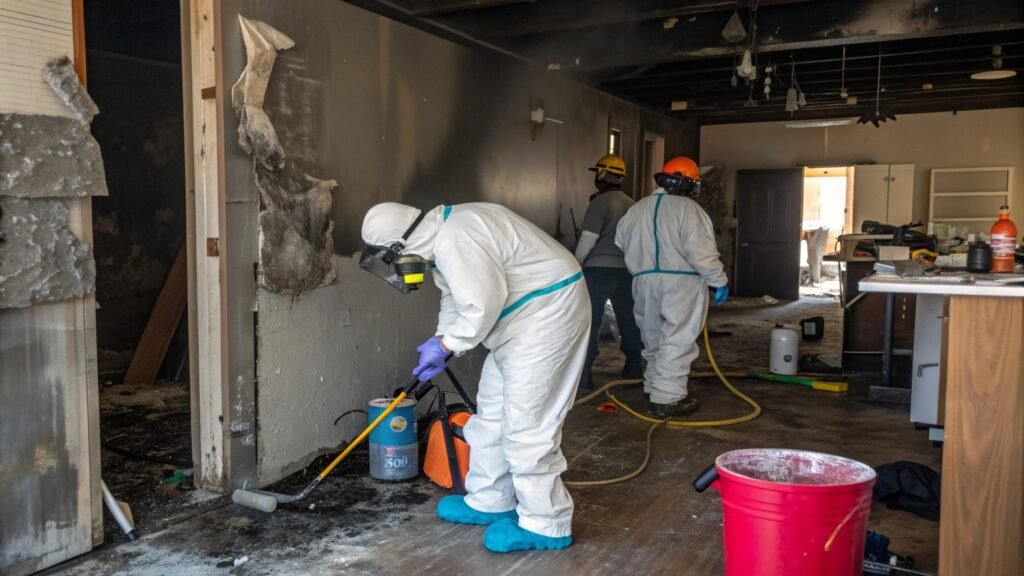Summary
Choosing the right fire damage restoration company is crucial for safely and effectively restoring your property after a fire. The best companies distinguish themselves through recognized certifications such as IICRC, NARSC, OSHA, and EPA Lead-Safe and adherence to industry standards like IICRC S500, NFPA guidelines, and ANSI compliance. These credentials ensure professionals have the expertise to assess fire and smoke damage accurately, perform thorough cleanup, handle hazardous materials safely, and follow ethical and legal practices. To verify a company’s credibility, check their documentation, confirm licenses, read customer reviews, and ensure proper insurance coverage, giving you confidence that your property is in capable, certified hands.
–
Introduction
Experiencing a fire in your home or business is traumatic, and the aftermath can be overwhelming. Beyond replacing damaged structures and belongings, thorough restoration is essential to ensure your property is safe, clean, and free from lingering smoke or soot damage. But with so many companies claiming to be experts, how do you know which ones truly deliver top-notch services? The answer lies in certification and industry standards. These credentials not only reflect a company’s technical expertise but also its commitment to safety, quality, and professionalism.
Why Certifications Matter in Fire Damage Restoration
Certifications play a critical role in fire damage restoration because they demonstrate that a company has the knowledge, skills, and training necessary to handle complex restoration challenges safely and effectively. Fire damage involves not only visible destruction but also hidden threats like smoke residues, soot, and water damage from firefighting efforts, which require specialized expertise to address. The best fire damage restoration companies prioritize certifications such as IICRC, OSHA, and EPA Lead-Safe to ensure their teams follow industry-approved methods, adhere to safety protocols, and deliver high-quality results. By hiring certified professionals, property owners can trust that restoration will be thorough, compliant with standards, and completed with both safety and efficiency in mind.
Key Certifications in Fire Damage Restoration
When searching for a reliable fire restoration company, look for these widely recognized certifications:
1. IICRC Certification: The Gold Standard
The Institute of Inspection, Cleaning and Restoration Certification (IICRC) is widely recognized as the gold standard in restoration services.
- What it is: IICRC sets the benchmark for cleaning, restoration, and inspection services across the U.S.
- Why it matters: Technicians trained under IICRC standards understand the science behind fire and smoke damage, including how to handle different materials, odors, and chemical residues safely.
- Popular certifications:
- Fire & Smoke Restoration Technician (FSRT) – Focuses specifically on fire damage assessment, cleanup, and odor control.
- Water Damage Restoration Technician (WRT) – Often necessary because firefighting introduces significant water damage.
A company with IICRC-certified technicians demonstrates professionalism, technical knowledge, and adherence to best practices.
2. EPA Lead-Safe Certification
Older homes and buildings may have lead-based paints. Fire damage restoration often involves demolition, sanding, or removal of materials that could release lead particles.
- What it is: The Environmental Protection Agency (EPA) Lead-Safe Certification ensures contractors follow strict safety protocols to prevent lead contamination.
- Why it matters: Protects occupants and workers from toxic exposure during restoration.
Even if your building is newer, an EPA-certified company shows attention to detail and regulatory compliance.
3. OSHA Compliance
Restoration work can be hazardous, involving heavy machinery, chemicals, and potential structural instability.
- What it is: The Occupational Safety and Health Administration (OSHA) sets safety standards for workers in hazardous conditions.
- Why it matters: Companies that comply with OSHA regulations prioritize employee and client safety, minimizing the risk of accidents during restoration.
4. Insurance and Bonding
While not a certification per se, being fully insured and bonded is a hallmark of a reputable restoration company.
- Insurance: Covers property damage or accidents that may occur during restoration.
- Bonding: Offers clients financial protection in case of theft, fraud, or incomplete work.
This is essential because fire-damaged properties are already vulnerable, and you want to minimize additional risks.
5. Industry Standards: NFPA Guidelines
The National Fire Protection Association (NFPA) develops and publishes codes and standards designed to promote fire safety and prevent fires.
- What it is: NFPA guidelines help restoration companies assess structural damage, identify fire hazards, and follow safe rebuilding practices.
- Why it matters: Aligning with NFPA standards ensures restorations are not only cosmetic but also structurally and chemically safe.
6. Local Licensing and State Regulations
Each state has its own requirements for fire damage restoration contractors.
- Check for: State contractor licenses, specialty restoration permits, or environmental certifications.
- Why it matters: Compliance with local laws ensures accountability and access to legal recourse if work is substandard.
7. Green and Eco-Friendly Certifications (Optional but Valuable)
Some companies now pursue eco-friendly certifications for sustainable restoration:
- Green Seal or LEED-related practices – Indicate the use of low-VOC materials and environmentally safe cleaning methods.
- Why it matters: Fire restoration can be chemical-heavy, so eco-conscious practices protect both your property and the environment.
Final Thoughts
The fire damage restoration industry has evolved into a highly specialized field where expertise, safety, and credibility are paramount. Companies that adhere to rigorous standards not only ensure the effective cleanup and repair of fire-affected properties but also provide peace of mind to property owners navigating a stressful situation. Choosing a certified fire damage restoration provider signals that the company has met stringent training and competency requirements, followed established industry protocols, and stayed updated on the latest restoration technologies. By prioritizing certifications and recognized industry standards, property owners can trust that their restoration process will be thorough, safe, and aligned with best practices in the field.





